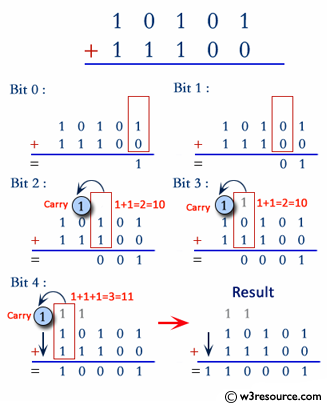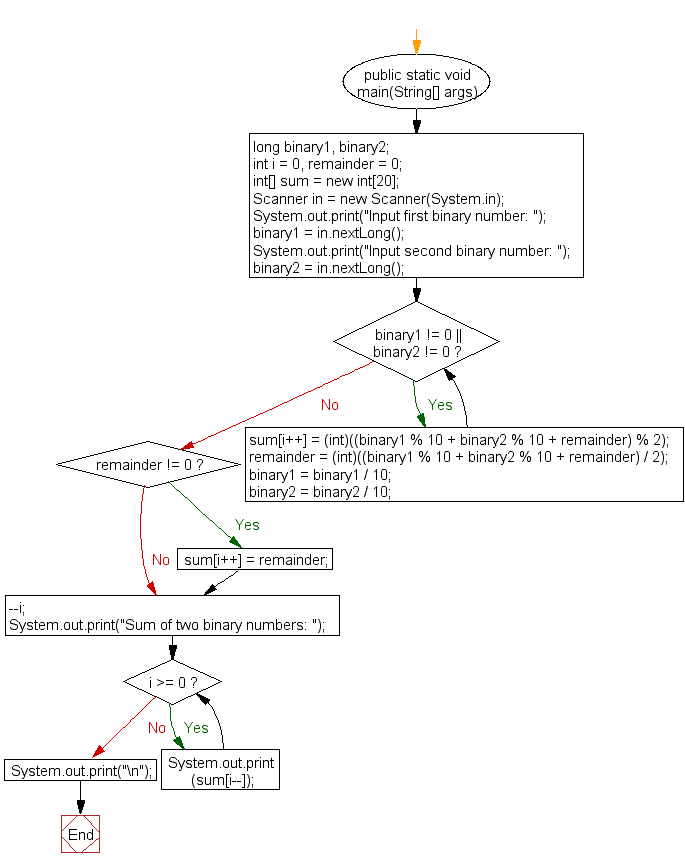Java: Add two binary numbers
Binary Addition
Write a Java program to add two binary numbers.
In digital electronics and mathematics, a binary number is a number expressed in the base-2 numeral system or binary numeral system. This system uses only two symbols: typically 1 (one) and 0 (zero).
Test Data:
Input first binary number: 100010
Input second binary number: 110010
Pictorial Presentation:

Sample Solution:
Java Code:
import java.util.Scanner;
public class Exercise17 {
public static void main(String[] args) {
// Declare variables to store two binary numbers, an index, and a remainder
long binary1, binary2;
int i = 0, remainder = 0;
// Create an array to store the sum of binary digits
int[] sum = new int[20];
// Create a Scanner object to read input from the user
Scanner in = new Scanner(System.in);
// Prompt the user to input the first binary number
System.out.print("Input first binary number: ");
binary1 = in.nextLong();
// Prompt the user to input the second binary number
System.out.print("Input second binary number: ");
binary2 = in.nextLong();
// Perform binary addition while there are digits in the binary numbers
while (binary1 != 0 || binary2 != 0)
{
// Calculate the sum of binary digits and update the remainder
sum[i++] = (int)((binary1 % 10 + binary2 % 10 + remainder) % 2);
remainder = (int)((binary1 % 10 + binary2 % 10 + remainder) / 2);
binary1 = binary1 / 10;
binary2 = binary2 / 10;
}
// If there is a remaining carry, add it to the sum
if (remainder != 0) {
sum[i++] = remainder;
}
// Decrement the index to prepare for printing
--i;
// Display the sum of the two binary numbers
System.out.print("Sum of two binary numbers: ");
while (i >= 0) {
System.out.print(sum[i--]);
}
System.out.print("\n");
}
}
Explanation:
In the exercise above -
- Initialize variables to store the two binary numbers ('binary1' and 'binary2'), an array 'sum' to store the sum, and other necessary variables.
- Takes two binary numbers from the user using the "Scanner" class.
- Next it enters a loop to perform binary addition from the least significant digit (rightmost) to the most significant digit (leftmost).
- Calculate the sum of the corresponding digits from both binary numbers and any remainder from the previous addition.
- Store the least significant digit of the sum in the 'sum' array.
- Update the remainder and divide both input binary numbers by 10 to move to the next digit.
- After the loop, if there's still a remainder left, it adds it to the 'sum' array.
- Prints the sum of the two binary numbers by iterating through the 'sum' array from the most significant digit to the least significant digit.
- The result is displayed as a binary number.
Sample Output:
Input first binary number: 100010 Input second binary number: 110010 Sum of two binary numbers: 1010100
Flowchart:

For more Practice: Solve these Related Problems:
- Write a program to add three binary numbers instead of two.
- Perform binary addition without converting to decimal.
- Write a program that adds two binary numbers of different lengths.
- Modify the program to add hexadecimal numbers instead of binary.
Go to:
PREV : Face Printer.
NEXT : Binary Multiplication.
Java Code Editor:
What is the difficulty level of this exercise?
Test your Programming skills with w3resource's quiz.
